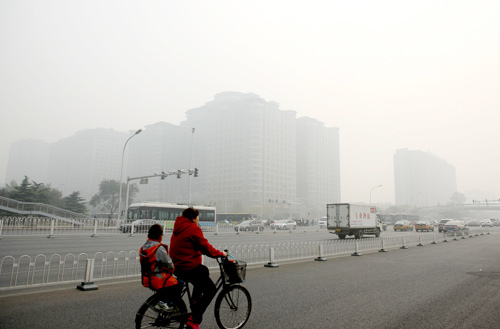|
 |
|
CITY IN FOG: Heavy fog shrouded Beijing on October 30 that reduced visibility to less than 100 meters (LI FANGYU) |
On November 8, seven Beijing residents, including a representative from a local environmental organization, were invited by the Beijing Municipal Environmental Protection Bureau (BMEPB) to visit its air-quality monitoring center.
The visit was the first of a regular program of visits that will take 40 visitors to the center every Tuesday in hopes of giving them a better understanding of how air-quality data are collected and analyzed.
The program marks the first time Beijing's environmental watchdog has opened its doors to individual visitors since it was established in 1974, although 340 schools, companies and other organizations have taken educational tours of the facility since it opened for group visits in 1997.
"We want the public to see how we work and further convince the public of the sincerity of our efforts," said Wang Xiaoming, a spokesman for the BMEPB.
The move came amid growing doubts from the public over the air-quality monitoring standards adopted by Beijing authorities. Such doubts were triggered by different air condition reports released by the BMEPB and the U.S. embassy in Beijing at the end of October.
Since October, haze and fog have blanketed Beijing on three occasions. The thick haze, which covered Beijing for as much as a week at a time and reduced visibility to a few meters, raised public concerns over the city's air quality and its impact on people's health.
On October 30, air monitoring data from the U.S. embassy in Beijing suggested that the density of PM2.5, fine particles with a diameter shorter than 2.5 microns, in the air was about 250 to 350 and the general air pollution index (API), an indicator of the air quality, was 425, reaching the level of "hazardous," the worst ranking on the pollution scale according to U.S. standards. However, the API released by the BMEPB on the same day was only 132 and the air was categorized as "slightly polluted."
An API reading below 50 indicates "excellent" air quality, while 50 to 100 shows "healthy" air and above 100 means the air is polluted, according to China's standards.
The U.S. embassy's evaluation of Beijing's air quality often differs markedly from the official Chinese rating. The embassy rated the city's air quality as "hazardous" on several occasions in October. On October 9, the reading was listed as "beyond index," allegedly meaning the amount of pollutants exceeded measurable levels.
Established in 2008, the embassy's air-quality monitoring system produces hourly updates of air quality. The readings are for ozone and for the concentration of PM2.5, the tiny airborne pollutants that cause haze and which can travel deep into the lungs and damage people's respiratory systems.
The PM2.5 standard was created by the U.S. Environmental Protection Agency (EPA) in 1997 for measuring air quality by counting fine particles of 2.5 microns in diameter and smaller.
Such particles are found in smoke and haze, or they can form when gases emitted from power plants, industries and automobiles react in the air, according to the EPA.
Part of the difference between the U.S. embassy and BMEPB figures can be explained by the use of different standards. China currently measures PM10 levels while the U.S. embassy measures the concentrations of PM2.5.
"The particulate matter currently measured in China is between 2.5 and 10 microns in diameter and is known as PM10," said Du Shaozhong, Deputy Director of the BMEPB.
By definition fog is the accumulation of vapor in the air and is largely transparent. Du said that the hazes that blanketed Beijing should actually be referred to as "smog," which is the combination of pollutants and fog.
Tang Xiaoyan, a professor at the College of Environmental Sciences and Engineering of Peking University, said research showed that Beijing's haze is caused mostly by PM2.5. "The contribution of larger matter is rather limited," she said.
But Du pointed out that while the U.S. embassy releases hourly updates of its PM2.5 monitoring results, the accuracy of these results is questionable because the data are only collected from a single spot.
| 